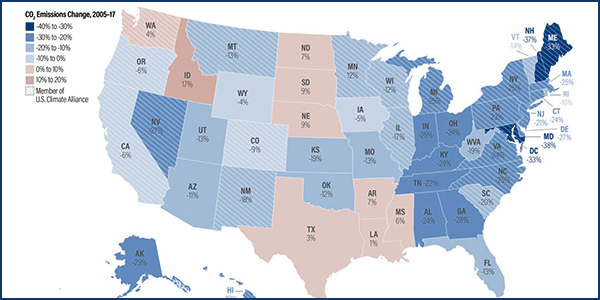World Resources Institute researchers made an economic case this week for climate action, given the COVID-19 pandemic.
Dan Lashof, the global research firm’s U.S. director, said 41 states have managed to reduce their carbon emissions in recent years while simultaneously growing their economies. That discredits the maxim that economic growth must come at the environment’s expense, he said.
Maryland topped the list of states decoupling carbon emissions and economic growth between 2005 and 2017, according to WRI’s new research. The state cut emissions by 38% while growing its gross domestic product by 18% during the 12 years. New Hampshire, Alaska, Georgia, North Carolina and Indiana also made the top 10 in cutting emissions while growing their GDPs by at least 13%.
“It’s a false choice between shrinking emissions and growing the economy,” Maryland Secretary of the Environment Ben Grumbles said during an Aug. 4 WRI webinar.
WRI Research Associate Joel Jaeger said Northeastern and Midwestern states made the most progress cutting carbon while expanding their economies. On the other hand, he said, Texas, the Dakotas and the Gulf States have not made any progress on emission reductions. Idaho was ranked last, experiencing a 17% rise in emissions as its GDP rose by 22%.
Jaeger said states can use large investments in clean energy to help restore the nation’s pandemic-stricken economy.
Lashof said a $1 million investment in clean energy in the U.S. creates twice as many jobs in the medium- to short-term than $1 million spent on fossil fuels.
“This is an ideal moment to scale up manufacturing and export of various low-carbon technologies,” said WRI Senior Associate Devashree Saha. Low interest rates typical in recessions make it a “particularly good moment,” she said.
Saha estimated that states need “substantial, but manageable” investments in low-carbon infrastructure. She said the U.S. would need additional annual investments equivalent to about 2% of GDP.
“Even at 2%, that is well within the historical range,” she said. “Energy spending in the United States is at a low point now at around 6% of GDP but has fluctuated to as high as 13%.”
WRI maintains the investments would be money well spent.
“Ignoring climate change is expensive … Delaying action on climate change will further expose the United States to costly damages from climate impacts, air pollution and other public health crises,” Jaeger said, using the nation’s response to the COVID-19 pandemic as an example. He estimated that without new climate policies, the U.S. could encounter economic damages equivalent to anywhere from 1% to 10% of GDP/year by 2100.
To honor the Paris Agreement’s more ambitious target of limiting global warming to 1.5 degrees Celsius, the U.S. needs to cut net emissions by 40 to 50% from 2005 levels by 2030 and aim for carbon neutrality by 2050. WRI said that means U.S. emissions must drop more than twice as fast from 2018 to 2030 than they did from 2005 to 2018.
WRI staff said that can be done with strong federal climate policies, such as carbon pricing and more investment tax credits.
“I think the federal government can amplify these efforts,” Saha said.




